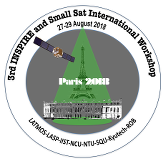Speaker
Dr
Ed Thiemann
(LASP, University of Colorado)
Description
Solar occultations served as an early work-horse for characterizing the temperature and density of Earth's thermosphere because of the technique's capability of making self-calibrated measurements of thermospheric density from roughly 90 to 400 km. However, solar occultations have been abandoned in recent decades, and few, if any, satellite-borne solar occultation instruments designed specifically for characterizing the thermosphere have ever flown. Meanwhile, few other methods have been proven capable of profiling the 120-300 km region of the thermosphere, leading some authors to label this region the "Thermospheric Gap" due to the lack of measurements over this region. Of recent interest is understanding the degree to which gravity waves heat or cool the thermosphere. And, while it is generally accepted that gravity waves contribute significantly to the thermosphere's energy budget, predictions of the amount of heating or cooling due to gravity waves vary widely.
The Occultation Wave Limb Sounder (OWLS) instrument scheduled to fly on the INSPIRESat-3 small-sat aims to measure gravity wave heating and cooling in the thermosphere by making solar occultation measurements from 90 to 400 km, spanning from the mesopause to the exobase. OWLS is capable of measuring major neutral species (O2, N2 and O) density and temperature at 1 km vertical resolution below 225 km, and 15 km resolution above 200 km. OWLS will achieve its science goals with two ultraviolet channels. One channel is an imaging MUV-FUV spectrograph for measuring O2 density and gravity waves from 90-225 km at high absolute accuracy and 1 km vertical resolution, using methods proven in the early 1970s. The second channel consists of two EUV photometers at 20 and 30 nm for measuring density, temperature and abundance from 150-400 km at 15 km vertical resolution using methods proven recently for EUV photometers at both Earth and Mars. This talk will describe the OWLS science objectives, instrumentation, measurement principles, and anticipated observations.
Primary author
Dr
Ed Thiemann
(LASP, University of Colorado)
Co-authors
Prof.
Amal Chandran
(Nanyang Technological University & LASP)
Dr
Francis Eparvier
(LASP, University of Colorado)
Dr
Katelynn Greer
(LASP, University of Colorado)
Dr
Marcin Pilinski
(LASP, University of Colorado)
Dr
Tom Woods
(LASP / University of Colorado)

